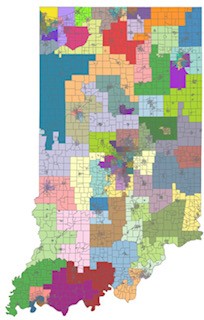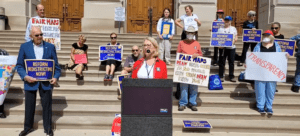
Pictured: Proposed Indiana House district map submitted to the Indiana Citizens Redistricting Commission by Fort Wayne schoolteacher Jorge Fernandez.
Redistricting reform groups launched an intensified campaign against Indiana House Republicans’ newly released redistricting proposal on Thursday, citing new academic findings that the new maps are gerrymandered and offering an alternative map that they said would provide for more competitive legislative elections.
Before an overflow crowd in the House chambers at the Indiana Statehouse, the House Elections and Apportionment Committee — expected to cast its vote on the enabling legislation on Monday — held its second public hearing on the proposed congressional and legislative districts that legislative leaders made public earlier this week. As in the first committee hearing on Wednesday, the public testimony was uniformly critical.
Representatives of the Indiana Citizens Redistricting Commission, a citizens advisory group composed of members of both major political parties as well as independents, told the committee that in addition to criticism, they came with a better idea — redrawn Indiana House districts (above) as submitted by Fort Wayne schoolteacher Jorge Fernandez in a map-drawing contest conducted by the commission. The entry from Fernandez, a former Democratic candidate in Indiana House District 50, was judged the winner of the commission’s contest; commission members said they plan to present the winning map submitted for congressional districts next week.
The Fernandez map, according to the commission, would include 23 “swing” House districts with the political balance needed for competitive elections. In addition to competitiveness, the maps submitted to the commission were judged on criteria including compactness and contiguity.
Leigh Morris, a Republican former mayor of LaPorte and a member of the redistricting commission, said the organization allowed voters in each of Indiana’s nine congressional districts to create their own maps.
Participants were instructed to create their maps while taking factors such as equal population size, keeping “communities of interest” (communities of similar ethnic and economic backgrounds) together and respecting the Voting Rights Act. Morris suggested the redistricting committee examine the maps voters created before passing the proposed maps to make sure they are fair and representative of what voters want.
“Examine your maps against ours,” said Sonia Leerkamp, a former Hamilton County prosecutor elected as a Republican but serving as an independent member of the commission. “Study where they are in agreement and where their differences are.
“Explain why you think yours are better. But consider also how ours might be better, and incorporate those ideas.”
Representatives of nonpartisan reform group Women4Change Indiana testified that an independent analysis of the new redistricting maps, conducted by George Washington University professor Christopher Warshaw, found that they would perpetuate the disproportionate Republican advantage that he found previously in the state’s 2011 redistricting.
“They basically recreate one of the most unfair gerrymanders in American history,” said Jay Yeager, a retired Indianapolis attorney who is an adviser on redistricting for Women4Change, calling the GOP redistricting proposal “incumbent preservation maps.”
“You’re acting in the interest of the people sitting in those seats,” said Yeager, who was lead counsel for voters in a 2019 federal court challenge to Michigan’s redistricting maps, and on a United States Supreme Court briefing supporting a 2017 challenge to the Wisconsin maps. “You’re not acting in the interest of the voters.”
Rima Shahid, executive director of Women4Change, warned that the maps would decrease voter turnout and harm Indiana’s democracy.
“These extremely partisan maps threaten the general welfare of our state … (and) rig the outcome of any and every election,” Shahid said. “These maps will lead to more extremist and polarized candidates because it will result in more uncontested races.”
Changes in the intersections of the 5th, 6th and 7th congressional districts also dominated public testimony on Thursday.
The maps would change the boundary lines for the 7th District to include the northern two-thirds of Marion County, a reliably Democratic area. This would take Marion County out of the 5th District and distribute the bottom third of the county to the 6th District, which currently represents much of rural Southeastern Indiana.
To Misty Hollis, the former vice chair of the Indiana Republican Party and current district chair of the 6th Congressional District, the incorporation of urban Marion County conflicts with the rural identity of the rest of the district.
“The majority of our district is rural Indiana, and we take great pride in preserving those values that represent our way of life,” Hollis, of Richmond, said. “The changes being made to our 6th Congressional District are very concerning to our constituents. …
“Re-imaging the district to include a portion of Marion County would in all likelihood lessen the influence of those who live in eastern Indiana.”
Hollis called for two separate votes, one on the Indiana House maps and one for the congressional maps, to better track lawmakers’ votes.
Others testifying Thursday were sharply critical of legislative leaders’ timing in scheduling a committee vote less than a week after the proposed redistricting was map public, with all legislative action expected to conclude within the following two weeks.
“That is plainly not enough time for the voting public to gain a solid understanding of how they maps were drawn,” said Jeff Stant, executive director of the Indiana Forest Alliance. “We ask you to give the public at least two more weeks.”
Rev. Fatima Yakubu-Madus of the Episcopal Diocese of Indianapolis did not want to waste time repeating criticism of the maps that others had shared, she said. Instead, she asked what it would take to cause lawmakers to change course.
“The only thing I want to ask this morning is, what can we do, what can we say to change your mind?” Yakubu-Madus said. “How can we say anything that will make you consider the maps that have been drawn by the Indiana Citizens Redistricting Commission?”
Added Gayla Sorenson, co-president of the League of Women Voters in Fort Wayne: “We are asking you to do the unexpected … We would like to be able to see headlines tomorrow that say, ‘In a surprise move, the process is being extended. In a surprise move, the maps actually created more competitive districts.'”
After public comments, state Rep. Matt Pierce, D-Bloomington, admonished the Republican supermajority for how they handled the redistricting process. Pierce noted, with the proposed maps, Republicans could represent 69 of the 100 Hoosier representatives despite only getting 56% of the vote.
“There was once a time where 53 [out of 100] was considered a supermajority,” Pierce said. “There’s been a rewriting of the norms of politics, and now there’s no way for the public to impact this process. … In a few weeks the majority will have sealed in complete dominance for another decade.”
In her testimony before the committee, Julia Vaughn, policy director for Common Cause Indiana and an organizer of the citizens redistricting commission, recalled meeting earlier this week with Rep. Greg Steuerwald, who said he thought she might like some of the redistricting proposal that he had authored.
Vaughn acknowledged that she did see improvements over the 2011 maps, including the way districts were drawn in Allen and Monroe counties, and that communities along the Lake Michigan shore had been intact.
However, she said the maps aren’t good enough, specifically when it comes to keeping communities of interest intact.
“Communities of color deserve districts that empower them,” Vaughn said. “These maps don’t hit the mark.”
In a post-hearing rally (below), Vaughn told a group of redistricting advocates not to be discouraged.
“We have made progress,” she said. “If we had this rally 10 years ago, we’d have had maybe 20 people That’s because people didn’t realize how important rdistricting is.”
Of the GOP redistricting proposal and the likelihood of its enactment, she added, “We’re not going to get everything we want out of this year. We’re not going to get everything we want out of these maps.
“But I’m going to take credit for some of the small improvements that we’ve seen because we provided a forum for people to make their voices heard.”
The House committee will vote on the maps Monday, and the full House will meet afterward to conduct its own vote. State Senate maps will be released Tuesday with testimony Sept. 27 and a full vote Sept. 28.
Senate maps are expected to be added to House maps on second reading, meaning the Senate isn’t planning to make any alterations. This allows the House to finalize all three sets of maps in one vote Sept. 22, before Senate testimony. — The Indiana Citizen
Whitney Downard of CNHI Indiana, Breanna Cooper of the Indianapolis Recorder and Taylor Wooten of TheStatehouseFile.com contributed reporting through The Indiana Citizen redistricting reporting project, which was organized with assistance from the Hoosier State Press Association.
